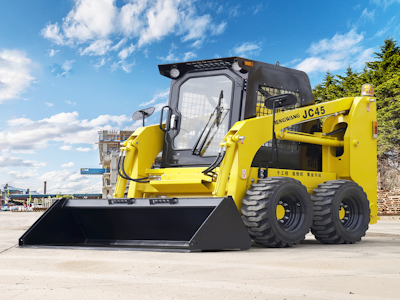


В современном мире строительная отрасль переживает стремительное развитие, и гидравлические автокраны играют ключевую роль в этом процессе. Эти мощные машины, оснащённые передовыми технологиями, не только упрощают сложные задачи подъёма и перемещения грузов, но и становятся символами инноваций в строительной технике. В данной статье мы подробно рассмотрим, как инновации преобразуют гидравлические автокраны, их влияние на эффективность, безопасность и устойчивость строительных проектов, а также перспективы будущего развития.
Гидравлические автокраны — это самоходные краны, использующие гидравлические системы для подъёма и перемещения грузов. Они широко применяются в строительстве, логистике, промышленности и других областях благодаря своей мобильности и высокой грузоподъёмности. Основные компоненты включают шасси, поворотную платформу, стрелу и гидравлические цилиндры, которые работают в симбиозе для выполнения точных операций. Исторически, первые автокраны появились в начале XX века, но с развитием гидравлики в 1950-х годах они стали более эффективными и надёжными. Сегодня эти машины эволюционировали от простых механических устройств до сложных интеллектуальных систем, интегрирующих электронику, автоматизацию и экологические решения.
Одной из ключевых областей инноваций является сама гидравлическая система. Современные автокраны используют высокоэффективные гидравлические насосы и клапаны, которые минимизируют потери энергии и повышают точность управления. Например, внедрение пропорциональных гидравлических клапанов позволяет операторам плавно регулировать скорость и силу подъёма, что критически важно для работы с хрупкими или тяжёлыми грузами. Кроме того, innovations like electro-hydraulic systems integrate sensors and microprocessors to optimize performance based on real-time data, reducing fuel consumption and wear. Такие advancements not only enhance operational efficiency but also contribute to longer machine lifespan and reduced maintenance costs. Внедрение smart гидравлики также включает системы автоматической компенсации нагрузки, которые предотвращают опрокидывание и улучшают стабильность крана даже на неровных поверхностях.
Электронные системы стали неотъемлемой частью современных гидравлических автокранов. GPS-навигация, датчики угла наклона и системы мониторинга в реальном времени позволяют операторам точно позиционировать кран и избегать accidents. Например, systems like load moment indicators (LMI) continuously calculate the crane's stability and warn operators if they approach dangerous limits. Автоматизация extends to functions such as auto-leveling, where the crane automatically adjusts its outriggers to maintain balance, and remote control capabilities that enable operation from a safe distance. Это особенно полезно в hazardous environments like construction sites with limited visibility or high-risk areas. Кроме того, integration with IoT (Internet of Things) enables predictive maintenance by analyzing data from sensors to forecast potential failures before they occur, minimizing downtime and enhancing safety.
Инновации в материалах science have led to the use of high-strength steel and aluminum alloys in crane construction, making machines lighter yet stronger. This reduces the overall weight of the crane, improving fuel efficiency and mobility without compromising load capacity. Additionally, advanced design software like CAD and FEM (Finite Element Method) allows engineers to optimize structural integrity, reducing stress points and increasing durability. For instance, telescopic booms made from composite materials offer extended reach with minimal weight, enabling cranes to handle taller structures with ease. These material advancements also contribute to better corrosion resistance, essential for cranes operating in harsh weather conditions or marine environments.
В ответ на растущие environmental concerns, производители гидравлических автокранов внедряют eco-friendly innovations. Гибридные и electric powertrains are becoming more common, reducing emissions and noise pollution on construction sites. Например, some modern cranes use battery-electric systems or hybrid engines that combine diesel and electric power, cutting carbon footprint by up to 30%. Кроме того, hydraulic fluids are now often biodegradable, and systems are designed for energy recovery, where kinetic energy from lowering loads is converted back into usable power. These sustainable practices not only comply with stricter regulations but also appeal to environmentally conscious clients, enhancing the marketability of construction projects.
Гидравлические автокраны находят применение beyond traditional construction, including in infrastructure projects, oil and gas industry, and disaster relief. In urban development,他们 используются для монтажа high-rise buildings and bridges, while in remote areas,他们的 mobility allows access to difficult terrains. Innovations like compact designs and multifunctional attachments enable cranes to adapt to specific tasks, such as handling containers in ports or assisting in emergency situations. For example, during natural disasters, автокраны с enhanced capabilities can quickly clear debris and rescue operations, showcasing their versatility and critical role in modern society.
Looking ahead, the future of hydraulic автокраны lies in further integration of AI and autonomy. fully autonomous cranes that can operate without human intervention are already in development, using machine learning to optimize lifting paths and avoid obstacles. Однако, challenges remain, such as high costs of new technologies, need for skilled operators to manage advanced systems, and regulatory hurdles. Additionally, cybersecurity risks with connected cranes require robust protections to prevent hacking. Despite this, ongoing research in areas like hydrogen fuel cells and advanced composites promises even greater efficiency and sustainability. The industry must focus on training and standardization to ensure safe adoption of these innovations.
В заключение, гидравлические автокраны продолжают эволюционировать благодаря непрерывным инновациям в технологиях, materials, и экологических решениях. Они остаются незаменимыми в строительной технике, обеспечивая повышенную эффективность, безопасность и устойчивость. По мере того как industry embraces digitalization and green practices, эти машины будут играть ещё более важную роль в shaping the future of construction and beyond. Investing in these advancements not only benefits businesses through cost savings and improved performance but also contributes to a more sustainable and resilient infrastructure globally.
Предыдущая статья: Какова минимальная партия при оптовой покупке экскаваторов
Следующий пост: Какова текущая стоимость экскаваторов на рынке